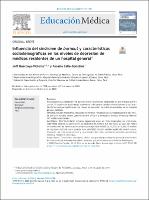Influencia del síndrome de burnout y características sociodemográficas en los niveles de depresión de médicos residentes de un hospital general
Related Resource(s)
https://www.sciencedirect.com/science/article/pii/S1575181320300371Date
2021-05Author(s)
Huarcaya Victoria, Jeff
Calle Gonzáles, Rosario
Metadata
Show full item recordAlternate title
Influence of the burnout syndrome and sociodemographic characteristics in the levels of depression of medical residents of a general hospital
Abstract
Introducción: La depresión y el burnout entre los médicos residentes es una entidad grave y común. El objetivo de este trabajo fue evaluar la influencia del síndrome de burnout y las características sociodemográficas en los niveles de depresión de médicos residentes de un hospital general del Perú.
Métodos: Estudio transversal realizado en médicos residentes de un hospital general del Perú. Se utilizó el Patient Health Questionnaire-9 (PHQ-9) y el Maslach Burnout Inventory (MBI) en 145 médicos residentes.
Resultados: El 27,6% tuvieron síntomas depresivos leves, el 13,8% moderados y el 5,5% moderadamente severos. La prevalencia de síndrome de burnout fue del 9,65%. El total del PHQ-9 se correlacionó de manera positiva con el puntaje total del MBI (ρ = 0,707; p < 0,01). El análisis de regresión múltiple con el puntaje total del PHQ-9 como la variable explicada mostró la existencia de una relación entre esta y las variables vivir solo, realización personal, encontrarse soltero y cansancio emocional.
Conclusiones: El cansancio emocional, el vivir solo y una baja realización personal incrementan los niveles de los síntomas depresivos, mientras que el encontrarse soltero los disminuyen. Introduction: Depression and burnout among medical residents is a serious and common entity. The aim of the present study is to evaluate the influence of burnout syndrome and sociodemographic characteristics on depression levels of medical residents of a general hospital in Peru.
Methods: A cross-sectional study was carried out on residents of a general hospital in Peru. The Patient Health Questionnaire-9 (PHQ-9) and the Maslach Burnout Inventory (MBI) were used to 145 resident physicians.
Results: 27,6% had mild depressive symptoms, 13,8% moderate, and 5,5% moderately severe. The prevalence of burnout syndrome was 9,65%. The total of the PHQ-9 correlated positively with the total score of the MBI (ρ=0.707, P<0.01). The multiple regression analysis with the total score of the PHQ-9 as the explained variable showed the existence of a relation between it and the variables living alone, personal accomplishment, being single, and emotional exhaustion.
Conclusions: Emotional exhaustion, living alone, and a low personal accomplishment increase the levels of depressive symptoms, while being single decreases it.
Collections
- Artículos científicos [890]






